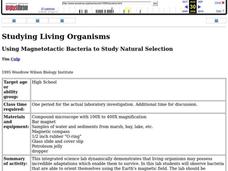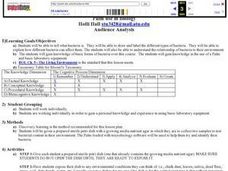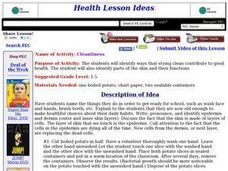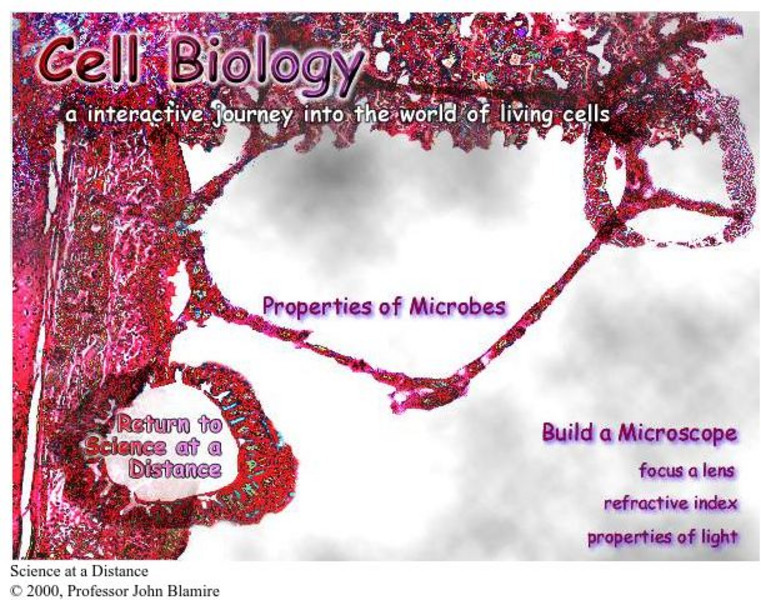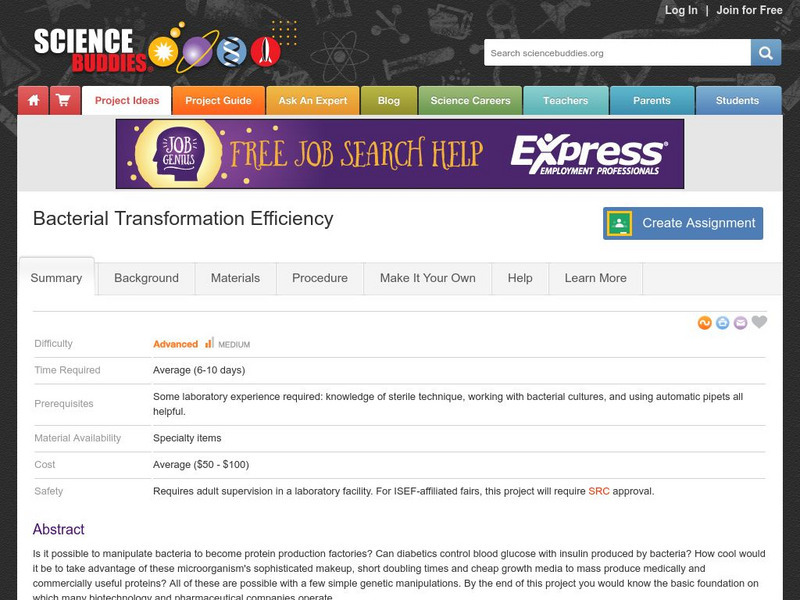Curated OER
Using Magnetotactic Bacteria to Study Natural Selection
Students demonstrate that living organisms may possess incredible adaptations which enable them to survive. They observe bacteria that are able to orient themselves using the Earth's magnetic field and formulate a hypothesis as to how...
Curated OER
Active Ingredient Screening Test for Plants
Students explore the growth of bacteria. They determine if various plant materials contain active ingredients that inhibit the growth of bacteria. In addition, they complete a student data sheet.
Curated OER
Selecting Soil Organisms in Compost
Young scholars conduct an experiment to demonstrate that many of the enzyme systems needed to break down society's wastes exist in nature among the decomposers in a compost pile. They culture compost bacteria on starch agar to examine...
Curated OER
E.coli and their Human Environment
Students observe how environmental changes (antibiotics) can affect the growth of E.coli, the rod shaped intestinal bacterium. They use the "F" test for statistical analysis. Students
Curated OER
The City From the Ooze
Learners investigate the life in the mud found around ponds. They create Ooze City using pond mud. Students investigate the various layers that form and what type of organisms are in the mud.
Curated OER
How Clean are the Laboratory Tables?
Young scholars participate in an experiment in which they test the cleanliness of the lab tables. They practice using different materials and analyze their results. They answer comprehension questions to end the lesson.
Curated OER
Multiplying Microbes
Students examine environmental conditions that effect bacteria growth. They culture bacteria, design and conduct an experiment, and identify the conditions that effected the bacteria growth using the scientific method.
Curated OER
Disease
Students study the differences between viruses and bacteria. They educate others to the harms and benefits of each by making a newspaper ad, pamphlet or informative article.
Curated OER
Cavern Life: The Food Web
Students explain the importance of elements on a food web. They realize that without light there can be no life. They perform various activities based on grade level.
Curated OER
Palm Use in Biology
Young scholars view bacteria through a microscope. They draw and label the bacteria using microbiology software loaded onto their Palms.
Curated OER
Can Bacteria Arise from Non-living Things?
Fourth graders, in groups, determine whether bacteria arises from non-living things,
Curated OER
Micro-organisms
Students examine how micro-organisms are living organisms that are often too small to be seen. They explain that micro-organisms may be beneficial or harmful.
Curated OER
Cleanliness
Students identify ways that staying clean contribute to good health. They perform an experiment involving potatoes and washed and unwashed hands, observing the results. They complete a cleanliness chart, checking off each healthful habit...
Biology Pages
Kimball's Biology Pages: Antibacterial Agents
This site lists the different antibiotics, tells how they disrupt the life cycle of the bacteria, and give examples of where in nature the antibiotic is from- i.e., penicillin -> bread mold.
BBC
Bbc News: What Is Anthrax?
Find out about the deadly bacterial disease Anthrax, and understand the symptoms and how it can be treated.
City University of New York
Cell Biology: An Interactive Journey
This interactive website about microscopes and microbes provides students with an introduction to cellular biology.
City University of New York
Brooklyn College: Direct Microscopic Counts
Guidelines for an activity through which you, acting as a research assistant for a wine merchant, work to grow a microbe under different conditions.
Michigan State University
Michigan State University: Digital Learning Center for Microbial Ecology: Microbe Zoo
Explore the "many worlds of hidden microbes" in different areas of the Microbe Zoo: DirtLand, Animal Pavilion, Snack Bar, Space Adventure, and WaterWorld. A fun and informative resource that sheds light on the role of microbes in our...
University of California
Ucmp: Cyanobacteria
General information on the cyanobacteria, the blue-green algae and the features that make them different from prokaryotic bacteria. Also included are pages that point to more specific info, like life history and fossil records.
University of California
Ucmp: Introduction to the Archaea
Berkley offers an introduction to archaebacteria--ancient bacteria--including the history of the topic, scientific findings, and where to find archaeans. Includes images and links.
Science Buddies
Science Buddies: Career Profile: Microbiologist
Microbiologists spend their careers peering through microscopes in their study of microorganisms. They have plenty to look at since these are Earth's most common life-forms. Science Buddies outlines the education requirements as well as...
Science Buddies
Science Buddies: Project Ideas: Is the Gold in My Jewelry Real?
In this science fair project, determine if the oligodynamic effect of gold on bacteria is strong enough to differentiate between jewelry of different karats. The Science Buddies project ideas are set up consistently beginning with an...
Science Buddies
Science Buddies: Germ Invasion
Microbes are everywhere in our environment, but for the most part they escape our notice. This project shows you how to safely culture and study common bacteria from your everyday surroundings.
Science Buddies
Science Buddies: Bacterial Transformation Efficiency
Is it possible to take advantage of microorganism's sophisticated makeup, short doubling times and cheap growth media to mass produce medically and commercially useful proteins? This is possible with a few simple genetic manipulations....


